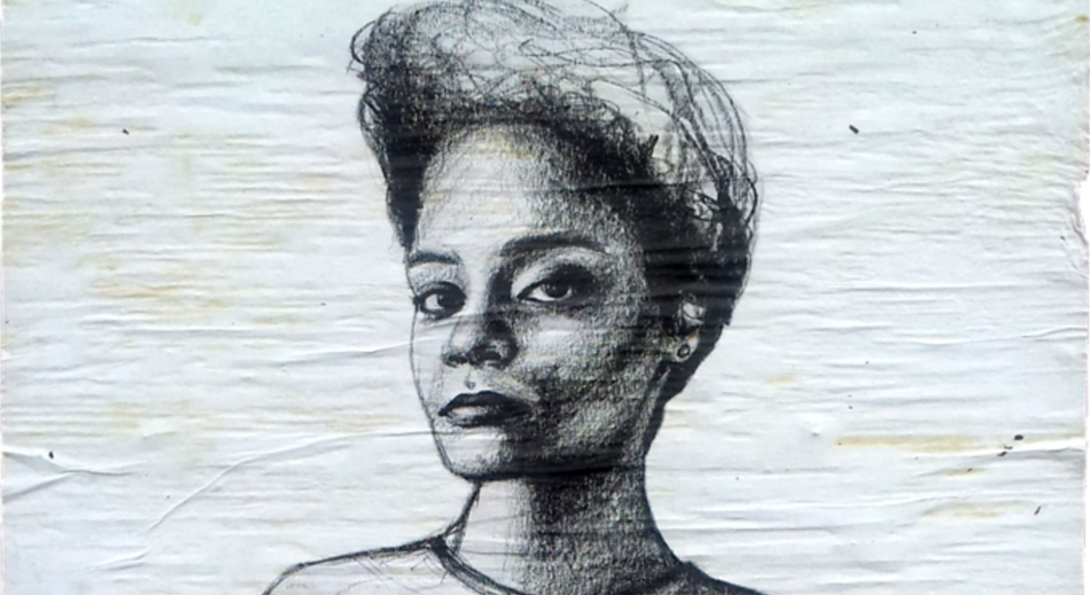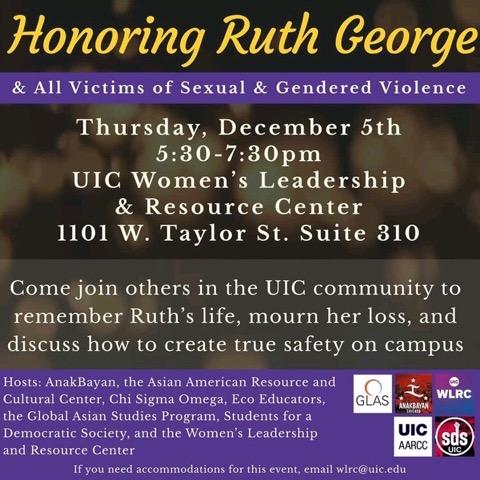Why Does She Have to Accommodate?

Why Does She Have To Accommodate? Heading link
As family, friends, UIC students, and faculty members continue to grieve over the loss of our own Ruth George, young girls, women, and those vulnerable to acts of street harassment continue to change the way they go about their daily lives.
Street harassment is a form of harassment, primarily sexual harassment, that consists of unwanted comments, gestures, car honking, wolf-whistlings, catcalling, and exposure that could lead to persistent sexual advances and unwanted touching by strangers in public areas (Haparimwi, 2016).
Those subjected to this type of harassment are often told by society to dress more modestly, attend a self-defense class, take a different route to their desired location, not to walk alone at night, or carry legal defense weapons such as pepper spray. I am in awe at how there is a constant bandwagon for solutions that are mainly victim-oriented. How do we sound suggesting accommodations for the lifestyles of potential victims instead of attacking the issue at its source? Not to say I’m against attending a self-defense class or carrying pepper spray for protection, but let’s stop tip-toeing around the problematic phenomenon that limits the mobility and access to public spaces for numerous young girls and women.
How should we prevent future sexual harassment while using a perpetrator-oriented solution?
Statistically speaking, men are more likely to be perpetrators in cases of street harassment. Yet, men are not constantly being reinforced or checked for their behavior towards gender-based street harassment.
If anything, the projection of western media, including television shows, commercials, and movies, encourages this type of behavior from men and young boys. Many of western society’s classical romance stories feature men using forms of street harassment like catcalling or driving slow alongside the sidewalk while saying suggestive comments about the appearance of the agent of sexual attraction. In these depictions, the agent of sexual attraction is flattered by the attention, but in reality, the majority of these individuals are rather disturbed, annoyed, and frighted by the described situation. I will not place all the blame on western media for this problematic phenomenon, but it definitely plays a role in normalizing the behavior of gender-based street harassment.
It is heavily stressed at the University of Illinois at Chicago, along with other colleges, that students complete a sexual assault prevention training before enrolling in the following semester. Although our society has these standards for college students and workers, it neglects to educate those who are not present in either position. Topics like sexual harassment and assault need to be heavily emphasized and constantly discussed amongst youth and older individuals (PERIOD), especially if it can educate them on the importance of boundaries, healthy communication, and managing romantic and/or sexual rejection.
I will even say UIC’s method of providing sexual assault training can stand to be improved upon as well. The training I am required to complete this semester was the same one I’ve completed two semesters ago. It has the same topics, situations, and reasonably appropriate response answers. Anyone who has taken this training before can absent-mindedly complete the training again.
There should be new information and topics discussed during this training every year. The position at which we learn about sexual harassment should not only be from a victim or friend of a victim’s point of view. This limited perspective makes me question if our administration views us students only as potential victims of sexual harassment and not as individuals prone to behaving in ways that would make us potential sexual harassers.
Incorporating lessons that discuss how to properly and respectfully approach an individual of interest, how to avoid behaving like a sexual perpetrator and, as previously mentioned, how to manage romantic and/or sexual rejection are just as essential towards understanding and preventing sexual harassment.
There are plenty of reported incidents at which knowledge about these topics would prove to be beneficial to everyone, such as in the violent case of a 14-year-old boy stabbing a 16-year-old girl 11 times for rejecting his request to advance their current relationship beyond friendship level (Quinlan, 2018) or in the deadly case of Ruth George (19), where her attacker (26) claimed to be angry that she ignored his catcalls.
These hostile reactions and sense of superiority over individuals, typically those who are more vulnerable, are caused by environmental factors (ex: home, school, friends, media). These lessons about being moral are not assessed until horrific incidents like the ones previously described happen. Sadly, victims of sexual harassment oftentimes feel the need to be polite and smile while rejecting their perpetrator’s advances in order for the situation to not escalate into sexual assault and/or a violent attack.
What I am proposing is constantly mandated sexual assault prevention training, whether virtual or in-person, for all individuals inside and outside of the workforce and education setting.
This training should educate participants on the physical, psychological, and emotional effects of street harassment so they can become allies and so they can intervene when they see it happening (Haparimwi, 2016). Mandated training will show perpetrators that sexual harassment is not and will not be tolerated at any point, place, or time.
There is definitely more research and community-building that needs to be done before a proper proposal for sexual harassment prevention can be presented to law officials and potentially approved. However, this problematic phenomenon has caught the attention of Mayor Lightfoot, at which she expressed George’s case as “alarming and devastating” (ABC7, 2019).
To reiterate, I would like to express that women, young girls, and those vulnerable to sexual harassment should not have to be fearful of rejecting unwanted attention and relationships. They should not have to change their livelihood in order to feel safe in public spaces. These individuals do not owe sexual harassers anything; not their body, a response, or even their attention! Let’s change how society views and reacts to sexual assault cases like George’s. Attack at the source!
Why Does She Have To Accommodate? Heading link
Cited Work
Haparimwi, Charlene. “Street Harassment Isn’t Just Annoying: It’s Psychologically
Damaging.” HuffPost, HuffPost, 7 Sept. 2016, https://www.huffpost.com/entry/street-harassment-isnt-just-annoying-its-psychologically_b_57cf0248e4b0273330aae785.
“Home.” Stop Street Harassment, http://www.stopstreetharassment.org/.
Quinlan, Casey. “Boy Stabs Girl at School Assembly up to 11 Times after She Rejected His Advances.” ThinkProgress, 27 Aug. 2018, https://thinkprogress.org/boy-stabs-girl-school-assembly-she-said-no-relationship-420be3070353/.
Wls. “’I Am Shaken to My Core by Such Cowardly Violence,’ Mayor Lori Lightfoot Says about Death of UIC Student Ruth George.” ABC7 Chicago, 26 Nov. 2019, https://abc7chicago.com/i-am-shaken-to-my-core-by-such-cowardly-violence-lightfoot-says-about-death-of-uic-student/5723463/.
Why Does She Have To Accommodate? Heading link
Your Opinion Matters!:
How do you feel society should respond to street harassment? What actions should we take?
Please follow me on my social media platforms for more updates on my current work:
Insta: @dramadollzz
